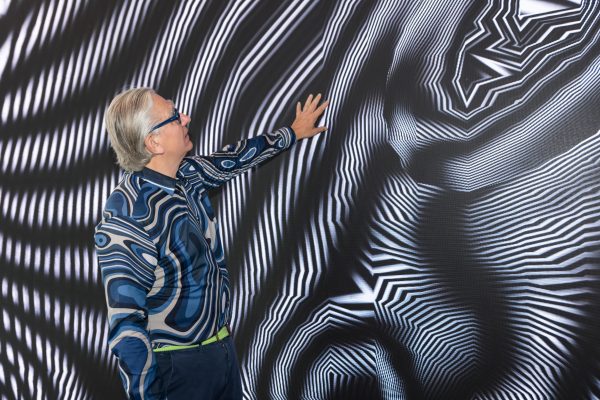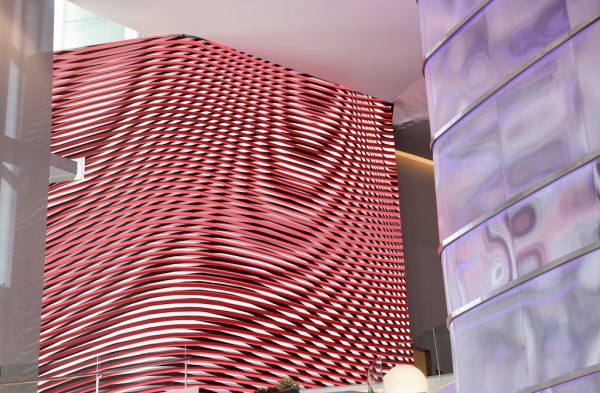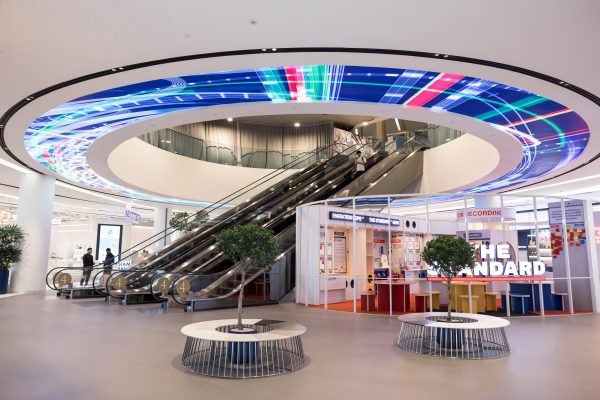The immersive world of Miguel Chevalier

Digital art may be very common today but 40 years ago, it was not recognised as “art” with non-enthusiasts regarding it as a waste of time and effort.
“In the early 1980s, I and my friends became interested in avant-garde art from the Western world. It was still very much a niche area. Computers were expensive and primarily used for scientific experimentation. Using computers as a creative tool for art seemed almost impossible. To me, however, it was like a test of whether I could create something entirely new as an artist using this technology,” French artist Miguel Chevalier told a fascinated audience at Siam Paragon where his latest digital works are on display.
Four decades ago, a new field of art started to emerge as Chevalier and many others began to create artworks featuring pixels and computer-generated graphics. The art community was not entranced by this medium, regarding Chevalier as a “technician” rather than an “artist”.
His first encounter with a computer, he told his audience at his “Digital Art Talk With Miguel Chevalier” lecture, was as a student at the National School of Fine Arts in France. At that time, computers were cutting-edge technology. His relentless pursuit of creating digital images required him to work day and night, experimenting and learning on his own.

“I didn’t see myself as just a ‘technician’ but as an artist who used software and computers as tools for creation,” he said.
Chevalier gradually learned and developed digital skills, and his journey has continued for over 40 years. It was, he said, a long and sometimes difficult journey to have his creations recognised as a legitimate art form. but he succeeded and earned his place as a pioneer of digital art.
His creations are an alternative approach to artistic expression and interpretation through innovative methods and new forms, offering a beauty that comes from techniques different from traditional painting, photography, or video because each genre possesses unique aesthetics.
His artworks have travelled around the globe, showing in a museum, at a public park, a private residence, a church, on top of a building and in shopping malls. The latest display can be seen on the wall of the newly opened space on Siam Paragon’s fourth floor
One of the top artists in this field, Chevalier is known for his innovative and immersive installations that often blend art and technology. At his lecture in Bangkok, he presented to his audience of students and digital art enthusiasts the inspiration from 2D images to digital art inspired by nature.

For example, his “Fractal Flowers 2023 (Seeds and Garden)”, currently exhibited in Seoul, South Korea, uses computer programs to create new, digitally rendered flower species that do not exist in reality.
Often, his artworks, which use technology to create dynamic and transformative experiences, engage viewers on a sensory and emotional level. The veteran artist believes that digital technology and digital art make it easier for people to interact with art. Techniques like projection mapping, computer-generated imagery and video projection onto walls, buildings, or even streets have expanded the possibilities for art to reach a wider audience.
He also sees the challenge of digital art as extending art beyond screens and into public spaces while preserving digital artworks for the future.
Chevalier has created numerous groundbreaking digital art pieces that have captivated global audiences. These include “Meta-Nature AI” (2023) in South Korea, “A l’infini” (2023) in France, “Digi Extra-Natural” (2023) in Germany, and “Digital Moirés” (2022) in Luxembourg. He has exhibited in Bangkok before, showing his “Magic Carpets” installation as part of the “Bangkok Illumination by Miguel Chevalier” at Iconsiam in 2018.
The best aspect of his work is that he can travel light, bringing only his ideas and creations to work with his team at the destination. “In my early days, I used to write the software programs myself but I’ve stopped. The task has gone to a new generation as many can do it and they do a good job too,” he said during a group interview with the media after his lecture.
Nowadays, open-source software is readily available to everyone, but you still need creative ideas and artists to produce art.
He added that while other art genres can be pursued by a single artist, creating digital arts is a fusion of contemporary art and technology. He collaborates with a team of experts in software programming and technical craftsmanship, while he focuses on ideation and concept development, ensuring that the technical algorithms align with the conceptual framework.
This time round in Bangkok, Chevalier’s artworks are quite special as it is the first time that he displays his work on LED walls as well as a circular screen – the latter designed specifically for this artwork.
In his works designed for presentation at the Bangkok mall this time round, Chevalier has created two cutting-edge digital art pieces namely “Vortex” and “Kinetic Waves”. These digital artworks go beyond mere virtual paintings, as they feature shapes, lines, and vibrant colours. But what makes them truly unique is their invitation to the audience to actively participate in the creative process and modify the artworks, offering the ultimate real-time art-tech experience. This engagement allows viewers to interact with the art and make modifications throughout the span of one year.
The “Kinetic Waves” series, in particular, is an Interactive Virtual Reality artwork that offers seamless interaction. It is created by generating geometric grids in up to 32 different variations, arranged and rendered with bright tonal colours. With effects that provide depth and texture, the artwork creates optical illusions.

“This means any time you come and take photos with the arts, there will be no identical shot over the one-year period,” he added.
What sets this experience apart in the realm of art tech is the active participation of viewers in the creative process, allowing them to modify and co-create the artwork through their movements within the entire area. This creates a new dimension for experiencing digital art with an ever-evolving perspective.
For his two latest pieces exhibited on the fourth floor of Siam Paragon, the primary keys are lightness, change and endless fluidity. They resemble technology and the digital world, which, even when not visible, are in constant motion.
For “Kinetic Waves”, an interactive piece with the audience starting from the walkway, he employs optical art, creating optical illusions by using geometric shapes and applying effects that convey depth and texture.
As one gets closer, the work becomes more exhilarating. The viewer becomes an integral part of reshaping this artwork through movement, creating an ever-evolving visual experience. “Kinetic Waves” features a total of 32 images that rotate every 2 minutes, and along with “Vortex”, will be exhibited continuously throughout the year.

“What I’m doing is extracting the beauty from the digital realm and designing it to be accessible to the public so that viewers have a more participatory role in art, beyond mere observation,” Chevalier said.
By Veena Thoopkrajae






